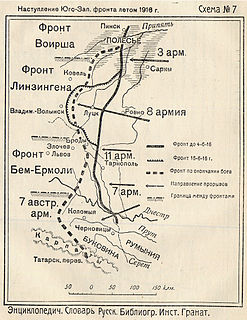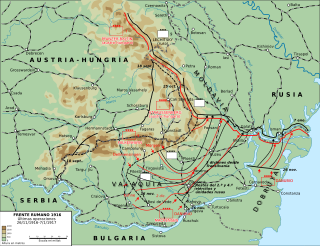
The 42nd Infantry Division was an infantry division of the British Army. The division was raised in 1908 as part of the Territorial Force (TF), originally as the East Lancashire Division, and was redesignated as the 42nd Division on 25 May 1915. It was the first TF division to be sent overseas during World War I. The division fought at Gallipoli, in the Sinai desert and on the Western Front in France and Belgium. Disbanded after the war, it was reformed in the Territorial Army (TA), in World War II it served as the 42nd Infantry Division with the British Expeditionary Force (BEF) and fought in Belgium and France before being evacuated at Dunkirk. The division was later reformed in the United Kingdom and, in November 1941, was converted into the 42nd Armoured Division, which was disbanded in October 1943 without serving overseas. A 2nd Line duplicate formation, the 66th Division, was created when the Territorials were doubled in both world wars.

The Royal Fusiliers was a line infantry regiment of the British Army in continuous existence for 283 years. It was known as the 7th Regiment of Foot until the Childers Reforms of 1881.

The Canadian Expeditionary Force (CEF) was the designation of the field force created by Canada for service overseas in the First World War. The force fielded several combat formations on the Western Front in France and Belgium, the largest of which was the Canadian Corps, consisting of four divisions. The Canadian Cavalry Brigade and the Canadian Independent Force, which were independent of the Canadian Corps, also fought on the Western Front. The CEF also had a large reserve and training organization in England, and a recruiting organization in Canada. In the later stages of the European war, particularly after their success at Vimy Ridge and Passchendaele, the Canadian Corps was regarded by friend and foe alike as one of the most effective Allied military formations on the Western Front. In August 1918, the CEF's Canadian Siberian Expeditionary Force travelled to revolution-torn Russia. It reinforced an anti-Bolshevik garrison in Vladivostok during the winter of 1918–19. At this time, another force of Canadian soldiers were placed in Archangel, where they fought against Bolsheviks.

The 1st Army was an army-level command of the Russian Imperial Army created during World War I. The First Army, commanded by General Paul von Rennenkampf, invaded East Prussia at the outbreak of war in 1914 along with the Second Army commanded by General Alexander Samsonov. After declaring war on the German Empire, the Russian Empire had been able to mobilize very quickly. All Russian forces were put under the command of Grand Duke Nikolai and his Quartermaster General Yuri Danilov.

The Allies of World War I or Entente Powers is the term commonly used for the coalition that opposed the Central Powers of Germany, Austria-Hungary, the Ottoman Empire and Bulgaria during the First World War (1914–1918).

The Russian Caucasus Army of World War I was the Russian field army that fought in the Caucasus Campaign and Persian Campaign of World War I. It was renowned for inflicting heavy casualties on the opposing forces of the Ottoman Empire, particularly at the Battle of Sarikamish. It was also known for its extremely diverse ethnic composition, consisting of units from throughout the Russian Empire and both soldiers and officers from the many ethnic communities settled since the 1877-78 Russo-Turkish War in the militarily administered Kars Oblast in the Russian Transcaucasus. These included Georgians, Caucasus Greeks, and Armenians - the latter in particular strongly represented among both the soldiers and senior officers - as well as ethnic Russians and Ukrainians.

The Russian Third Army was a World War I Russian field army that fought on the Eastern theatre of war.
The Russian Sixth Army was a World War I Russian field army that fought on the Eastern theatre of war.

The Northern Front was an army group of the Imperial Russian Army during the World War I. It was responsible for carrying out operations against the Central Powers along a front line that stretched 280 kilometers, from Riga in the north down to northern Belarus. It was established in August 1915 when the Northwestern Front was split into the Northern and Western Front following the Great Retreat, and existed until the demobilization of the Russian army in 1918 due to the unrest from the Russian Revolution. In 1917 it had a total troop strength of 1.4 million men.
The Russian Fourth Army was a World War I Russian field army that fought on the Eastern Front.

The 10th Army was a field army of the Imperial Russian Army during the First World War.
The Russian Fifth Army was a World War I Russian field army that fought on the Eastern theatre of war.
The Russian 11th Army was a World War I Russian field army that fought on the Eastern theatre of war.

The Russian Eight Army was a World War I Russian field army that fought on the Eastern theatre of war.
The Russian 7th Army was a World War I Russian field army that fought on the Eastern theatre of war.

The Russian 12th Army was a World War I Russian field army that fought on the Eastern theatre of war.
The Russian Special Army was a World War I Russian field army that fought on the Eastern Front.
The 13th Army Corps was a corps of the Imperial Russian Army, formed in the 1870s. The corps fought in the Russo-Turkish War and World War I, and was disbanded with the collapse of the Imperial Russian Army after the Russian Revolution. During peacetime, it was stationed in the Moscow Military District.
The 5th Siberian Rifle Division was an infantry unit of the Imperial Russian Army. The division was formed in 1904 from a brigade, fighting in the Russo-Japanese War and World War I.












